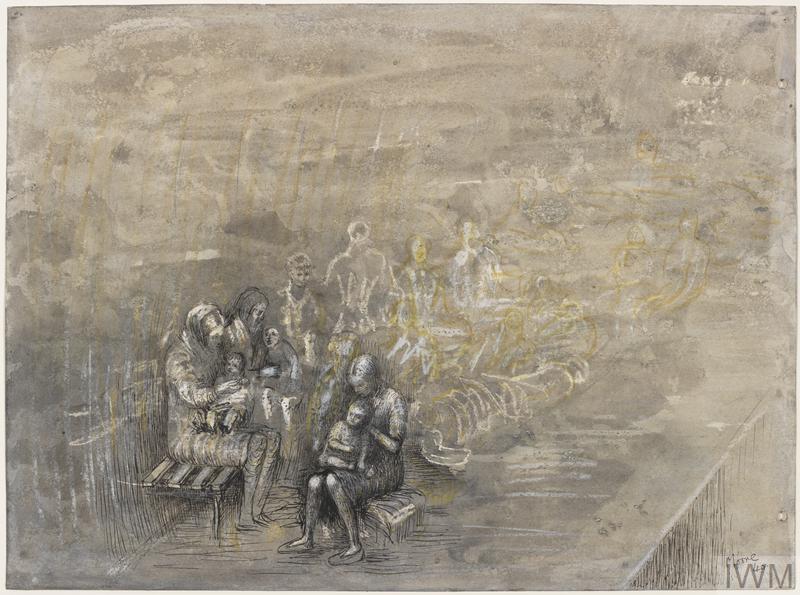The Art of World War I
World War I affected the lives of everyone involved, from the soldiers to the civilians near the fighting to those waiting back at home for their loved ones. It was a horrific point in our history, when outdated battle tactics met modern weapons such as machine guns and mustard gas. Nearly three million people died in just Germany alone, and we still reference trench warfare as being a miserable and grueling affair. With war being such an emotional time, it makes sense why one that involved nearly the entirety of Europe would influence one of the most emotional fields; art.
Tunnellers, Christopher Nevinson, 1916, Britain
Tunnellers is a work I greatly enjoy. The value of the piece is incredibly striking, with harsh darks and sharp beams of light creating an eerie atmosphere. The use of cool colours gives it a dreary look, as if the environment depicted were frigid to the touch. The figure's gas mask adds to this feeling of unease, the textures of the graphite and crayon used giving it a scratchy, grainy look that only builds on the discomfort and dread of it all. Gas masks were commonly used in WWI, as the use of toxic gases such as mustard and chlorine gas made them a necessity. Nevinson likely had to use them himself, as he was a part of the Friends' Ambulance Unit and had to tend to wounded French and British soldiers, which would have placed him in the trenches - a prime target for gas attacks.
Portrait of a German Officer, Marsden Hartley, 1914, Berlin, Germany
Of course, soldiers weren't the only ones affected and making art. Many people lost loved ones and decided to immortalize them on canvas, such as American painter Marsden Hartley. Hartley was a homosexual man who moved to Berlin in 1913, where he met Karl von Freyburg, whom he is speculated to have fallen in love with. Freyburg died in battle at the age of 24 in 1914, which drove Hartley to create this piece. Portrait of a German Officer utilizes bold colours and abstract shapes to show the clash between Germany's strong nationalism and Berlin's liberal sexuality, with all the bold and interesting lines coming together in an homage to Freyburg's life and death. We can see details such as his initials, regiment number, and age of death hidden about the piece, making this painting an impactful example of the loss experienced by the loved ones of soldiers. The history of this piece makes me quite emotional, as there are so very few surviving pieces of gay artwork, and knowing how this was done in honour of someone Hartley lost gives it a bittersweet sense of pride and grief.
Group of French Tank Corps Members, World War I Era, Unknown Photographer, 1916
The impact of WWI wasn't limited to paintings and sketches; photography blew up during the war, as this was the first major war to be able to have actual photographs from the front lines sent back to the newspapers at home. A large portion of them displayed the horrors of war, causing many civilians to become heavily anti-war, wanting their family and friends to return home safely. But carnage wasn't the only thing captured on camera, and photographs such as this one are just important to see and remember. The contrast of black and white seems to add a feeling of loss to this photo, and the composition with the wall and windows behind them gives it an almost caged look. Whenever I look at pictures like this, I feel a sort of solemn stillness take hold of me. It makes me wonder how many of the men pictured here survived the battles, what their names were, whether they ever got to go home. The reality of war is a cold and brutal one, but moments like these, with young men lining up for a group photo, reminds us of the humanity of those involved, adding weight to the casualty statistics we read in our textbooks.
Information Sources:
https://www.sartle.com/artwork/portrait-of-a-german-officer-marsden-hartley





Hello Jeks! I greatly enjoyed your blog this week. You did a great job introducing the time period and thoroughly explaining the history of each piece. I enjoyed the three pieces you chose for your blog also. Your first piece, “Tunnellers,” is so frightening and eerie. I love the detail in the wood and how realistic the logs appear. The gas mask is disturbing. I think the most effective aspect of this piece is the placement of the soldier and the long, dark tunnel … very dramatic. Your second piece, “Portrait of a German Officer,” is a great example of color and nationalism. The history is profound and adds terms of sentiment to the viewing of this piece. I really enjoyed your observations of the photograph…the solemn stillness. It’s disturbing to me how the soldiers’ faces are difficult to make out, like they are blurry … almost like a loss of the simple humanity of the photo. Great job!
ReplyDeleteI love this blog. I think displays of art like this give a very emotional response. I am not going to lie that I might have cried while reading it. My favorite is the Tunnelers. Even though it might have an eerie feeling to it I also see it as a light that illuminates the darkness that is caused by war. I also really love the photograph. It also saddens me that there is not a lot of information about the people in the photo, but I love this work.
ReplyDelete